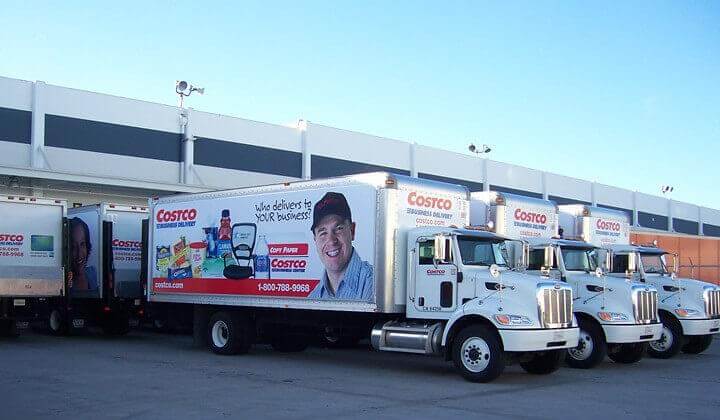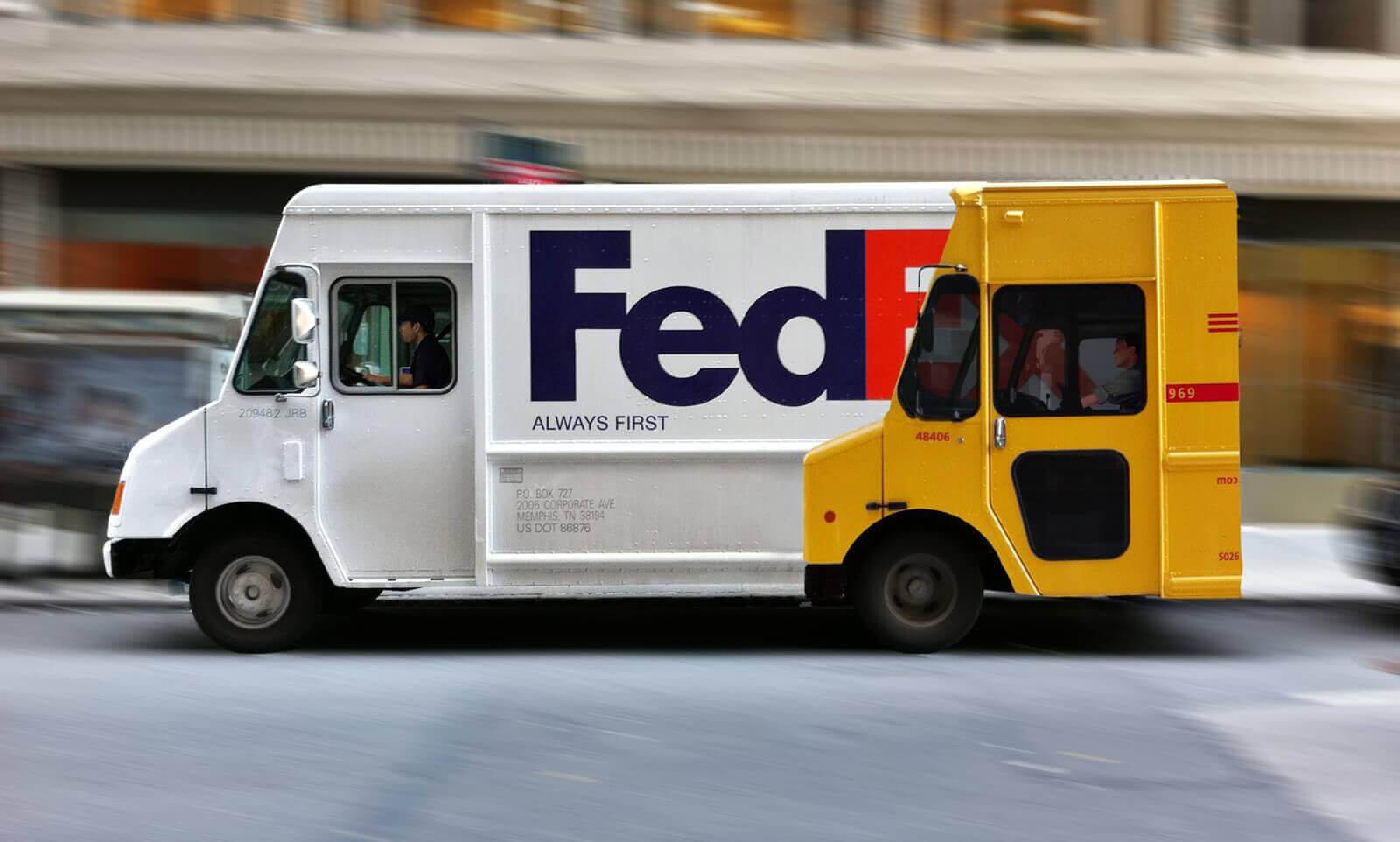
This year, Fortune 500 companies represent two-thirds of the U.S., have a GDP of $13.7 trillion in revenues, $1.1 trillion in profits, $22.6 trillion in market value, and employ 28.7 million people internationally. Fortune 500 companies can be publicly held or privately held, where their revenues are publicly available for people to see. As of 2019, companies are ranked by total revenues for their respective fiscal years reported by their 10-K filings. Making the top 10 list of Fortune 500 companies this year included Walmart at #1, followed by Exxon Mobil, Apple, Berkshire Hathaway, Amazon.com, UnitedHealth Group, McKesson, CVS Health, AT&T, and AmerisourceBergen. Now, these are just the beginning of a long list of companies that have successfully secured their position on the Fortune 500 list.
This post is interested in looking at the way some of these companies have incorporated truckside advertising in their marketing mix to help evolve their advertising ploys. Some of the top companies in the world, and on Fortune 500, have used mobile billboards to advertise their businesses and their products. Let’s take a deep dive into Fortune 500 companies that have done truck side advertising and see how it has helped them from a corporate and consumer driven standpoint.


Walmart’s Truck Side Advertising Efforts
Holding the #1 spot on this year’s Fortune 500 list, it’d be a marketing crime not to talk about Walmart’s truckside advertising displays that help to steer their business forward through store directions and product promotions. Walmart’s truck side advertising is a nod to their new store openings, as well as a means of displaying their insanely low prices. Walmart’s “rollback” pricing strategy is one of the key selling points for consumers to shop their store. They conveniently cut down prices so dutiful consumers can continue visiting their local Walmart locations and, ultimately, dish out more money if the savings are decent. Their mobile billboards reflect this pricing strategy and continue to serve as a means of showcasing their lowest price possible mentality.
Walmart’s truck side advertising also caters to more local audiences by placing the region name within its marketing message. Taking a look at the first photo above, Walmart says “Colorado Proud Products” which makes consumers feel better about how close their produce is coming from. Consumers enjoy buying locally, and Walmart is guaranteeing that an array of their products are brought in from local sources. Their truck side advertising casts a huge light on their corporate pricing strategy as well as their regional strategies to alert consumers in the area of store openings and directional content.

AT&T’s Mobile Billboards
Placing #9 on Fortune 500’s list this year is AT&T- the American multinational conglomerate holding company that has birthed broadband, digital television, home security, and satellite television services among many others. AT&T is a telecommunications company that provides all things electronic and digital to many marketplaces of consumers. Their truck side advertising actually takes the form of smaller vehicle wraps that showcase their product line in visually poignant and colorful ways. As pictured above, one of their vehicles clearly displays one of their products, the AT&T U-verse, which happens to be a refined television available for purchase. Their mobile billboard efforts give way to their product line while also being smart to include call-to-actions, such as website and phone number.
AT&T is a conglomerate that knows it must still market itself to be ahead. Even though it’s a highly regarded and successful company, it has to remain presentable and distinguishable to consumers travelling on the road. Their vehicle wrap advertising is just another tactic to keep their products on full display. With the use of bright colors splattered on a plain white vehicle, AT&T is releasing their most sought after products to audiences on the commute.

Costco Wholesale Truckside Ads
Taking the 14th place on Fortune 500’s list is Costco Wholesale, which is an American multinational corporation that operates a long chain of membership-exclusive warehouse clubs. Costco wholesale is one of those shopping centres where you’re able to find just about anything under one roof, at great prices. Costco carries an expansive selection of different products and a variety of household needs. Their products are usually sold by the plenty, and buying in bulk is what they do best. Their truck side advertisements reflect the large scale of their wholesale stores. Costco’s truck ads are large, in your face, and feature products in which they carry. Their truck ads mostly highlight their business delivery services, and include a phone number to one of their local stores.
For Costco, it’s important for them to get consumers aware of where their locations are. Once people visit a Costco, and get a membership, they’ll most likely be back again and again. Some Costco’s are advertised more so on a word-of-mouth basis, where a friend may take their friend shopping to one then, consequently, their friend will get a membership because of the positive experience they had. But, in the meantime, Costco advertising on their trucks doesn’t affect their business negatively. Their truck ads help to strengthen the foundation of their business model and make more consumers aware of the wholesale lifestyle that they can be a part of.

Home Depot Truck Ads
Making a splash onto #27 of Fortune 500’s list is Canadian home improvement company Home Depot. The first Canadian born company we’re talking about on this post has successfully been providing consumers with home improvement products and furnishings since 1978. Home Depot’s truck side advertising is not concerned with showcasing their products, but instead is an outlet to talk about their vehicle renting services. Home Depot provides truck rentals for consumers needing to move their purchases to their homes, and they feature this service on their mobile billboards.
The iconic Home Depot orange apron is showcased on their ads with copy directly hitting at their rental services. They include pricing by the minute on their truckside ads, furthering their rental transparency and abundance of services. Their truck rental services allow consumers to transport small and large items safely to homes, offices, or job sites without damaging an existing vehicle one may own. The rentals are available across Canada. Cargo vans, pickup trucks, and trailers are all available to rent from Home Depot, and their truck side ads bring attention to this valuable service.

State Farm Insurance Mobile Billboards
Coming in at #36 on the list is State Farm Insurance, a large group of insurance and financial services companies within the U.S. as well as Canada. State Farm offers comprehensive coverage that pays to repair or replace an insured vehicle that’s stolen or damaged by anything other than a collision. They are the largest insurer of vehicles in the U.S. and offer competitive pricing with easy claims. Referring to their vehicle advertising, they’re interested in showcasing local agents that work for them to provide easy insurance representation and information. Their vehicle vinyl wraps typically advertise a licensed agent that is available to have insurance related conversations with people looking for State Farm.
As is shown in the image above, a truck is wrapped in red State Farm Insurance vinyl that outlines the services of an agent working for them. It’s very informative, as the phone number of the agent is posted on both the back and the side of the vehicle. It also gives a website so drivers and passengers are able to find out more about the company and how it’s working on a regional level. State Farm Insurance is using truck side advertising to raise awareness for their local agents, and advertise the help of an employee as well as the help of the greater business.

Target Vehicle Advertising
The Target Corporation is the eighth-largest retailer in the United States and has placed #39 on Fortune 500’s compiled list. Even though Target didn’t necessarily work out well in Canada, the company is still a mega hit in the States and is a staple in retail culture. Similar to Costco, in that it has mostly everything you need under one roof, Target’s vehicle advertising takes form on double decker buses, sightseeing vehicles, and trucks. Target’s vehicle advertising mostly shows their range of products and their push for produce. As in shown in the image above, a double decker bus is plastered with fruits and vegetables now sold at Target. Their copy playfully uses “sights” in two meanings, cleverly drawing in audiences.
Because Target is already a very well established company, their advertising doesn’t need to be too informational or directional. Most consumers already know where Target stores are located on the premise that there’s so many of them in the States. What Target is strategically doing with their vehicle ad spaces is showing an introduction of new products in their stores. This is smart of them to advertise because it keeps consumers coming back to buy something new and fresh.

FedEx Truck Advertising
Although this ambient advertisement by the Miami Ad School has already been mentioned in another blog post, it’s notable to talk about it here because FedEx ranked #47 on the Fortune 500 list this year. This recognizable and widely used delivery service used truck side advertising to poke a little fun at their competition, DHL courier. They’re using visual cues to imply that their service is always quicker than the competition. Since FedEx is already people’s top choice for delivery and courier needs, there’s no need for the company to boast about their unique selling points through truck side text. Instead, the company turned their truckside advertisement into a little bit of a cheeky visual metaphor. Staying true to their tagline, FedEx is “always first” to deliver to the consumer.

Coca-Cola Christmas Truck
This is an example that strays from the other truck side advertisements brought to you by Fortune 500 companies. Coca-Cola, placing #100 on the list, has used an iconic festive truck to spread Christmas cheer to areas across the UK in 2017. Since Cola-Coca is one of the most influential and recognizable brands in history, especially within their advertising, they are smart to use a mobile truck with Christmas lights attached to send holiday vibes to different locations. Coca-Cola is using truckside advertising not to increase the popularity of Coke, but to infiltrate the Christmas market of outdoor advertising. By positioning their brand on a brightly lit truck, they’re making themselves now known as a shared Christmas beverage among consumers. This beautifully bleeds into their already iconic Christmas story with the polar bear.
Fortune 500 companies shape the way the world sees advertising. With the integration of truckside advertising, Fortune 500 companies can continue their legacy. From looking at the ways that Walmart, AT&T, Costco, Home Depot, State Farm, Target, FedEx, and Coca-Cola uses mobile billboards to carry out their advertising messages it’s clear to see that each company is fighting for a position to make a positioning statement on the roads. Fortune 500 companies have solidified their spot on this year’s list through revenue and profit, among other qualities, but advertising, especially in the category of OOH, helps move them forward.


